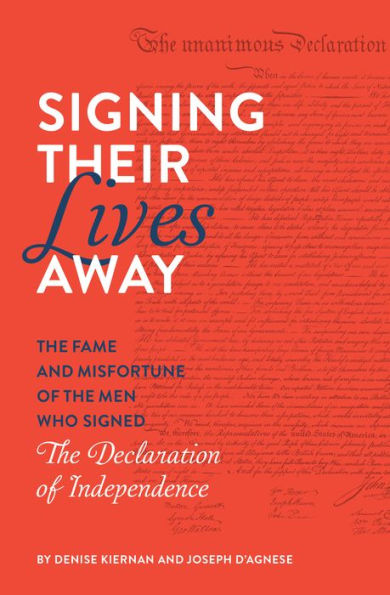Signing Their Lives Away: The Fame and Misfortune of the Men Who Signed the Declaration of Independence
An entertaining and essential collection of stories about the surprising and strange fates of the fifty-six Founding Fathers who signed the Declaration of Independence.
In the summer of 1776, a group of 56 men risked their lives and livelihood to defy King George III and sign the Declaration of Independence—yet how many of them do we remember? Signing Their Lives Away introduces readers to the eclectic group of statesmen, soldiers, slaveholders, and scoundrels who signed this historic document—and the many strange fates that awaited them. To wit:
• The Signer Who Was Poisoned By His Nephew
• The Signer Who Was Killed In a Duel
• The Signer Who Went to Prison
• The Signer Who Was Lost at Sea
• The Signer Who Achieved Fame as a Brewer
Complete with portraits of every signatory, Signing Their Lives Away provides an entertaining and enlightening narrative for students, history buffs, politicos, and Hamilton fans alike.
1015204326
In the summer of 1776, a group of 56 men risked their lives and livelihood to defy King George III and sign the Declaration of Independence—yet how many of them do we remember? Signing Their Lives Away introduces readers to the eclectic group of statesmen, soldiers, slaveholders, and scoundrels who signed this historic document—and the many strange fates that awaited them. To wit:
• The Signer Who Was Poisoned By His Nephew
• The Signer Who Was Killed In a Duel
• The Signer Who Went to Prison
• The Signer Who Was Lost at Sea
• The Signer Who Achieved Fame as a Brewer
Complete with portraits of every signatory, Signing Their Lives Away provides an entertaining and enlightening narrative for students, history buffs, politicos, and Hamilton fans alike.
Signing Their Lives Away: The Fame and Misfortune of the Men Who Signed the Declaration of Independence
An entertaining and essential collection of stories about the surprising and strange fates of the fifty-six Founding Fathers who signed the Declaration of Independence.
In the summer of 1776, a group of 56 men risked their lives and livelihood to defy King George III and sign the Declaration of Independence—yet how many of them do we remember? Signing Their Lives Away introduces readers to the eclectic group of statesmen, soldiers, slaveholders, and scoundrels who signed this historic document—and the many strange fates that awaited them. To wit:
• The Signer Who Was Poisoned By His Nephew
• The Signer Who Was Killed In a Duel
• The Signer Who Went to Prison
• The Signer Who Was Lost at Sea
• The Signer Who Achieved Fame as a Brewer
Complete with portraits of every signatory, Signing Their Lives Away provides an entertaining and enlightening narrative for students, history buffs, politicos, and Hamilton fans alike.
In the summer of 1776, a group of 56 men risked their lives and livelihood to defy King George III and sign the Declaration of Independence—yet how many of them do we remember? Signing Their Lives Away introduces readers to the eclectic group of statesmen, soldiers, slaveholders, and scoundrels who signed this historic document—and the many strange fates that awaited them. To wit:
• The Signer Who Was Poisoned By His Nephew
• The Signer Who Was Killed In a Duel
• The Signer Who Went to Prison
• The Signer Who Was Lost at Sea
• The Signer Who Achieved Fame as a Brewer
Complete with portraits of every signatory, Signing Their Lives Away provides an entertaining and enlightening narrative for students, history buffs, politicos, and Hamilton fans alike.
15.99
In Stock
5
1

Signing Their Lives Away: The Fame and Misfortune of the Men Who Signed the Declaration of Independence
304
Signing Their Lives Away: The Fame and Misfortune of the Men Who Signed the Declaration of Independence
304Paperback(Reprint)
$15.99
15.99
In Stock

Product Details
| ISBN-13: | 9781683691266 |
|---|---|
| Publisher: | Quirk Publishing |
| Publication date: | 04/30/2019 |
| Edition description: | Reprint |
| Pages: | 304 |
| Sales rank: | 113,944 |
| Product dimensions: | 5.30(w) x 7.90(h) x 1.10(d) |
| Age Range: | 11 - 17 Years |
About the Author
From the B&N Reads Blog
